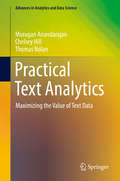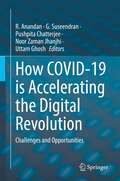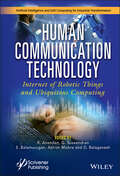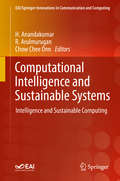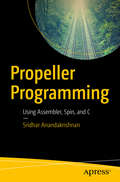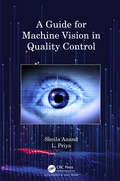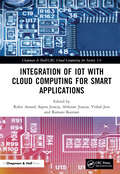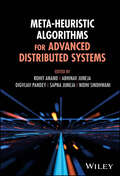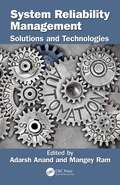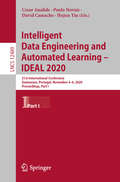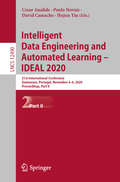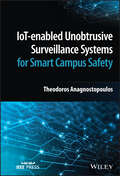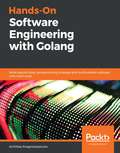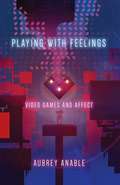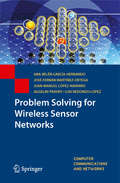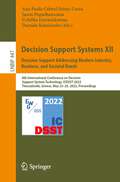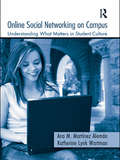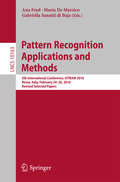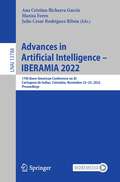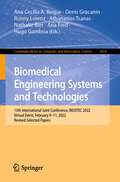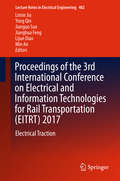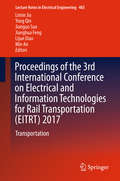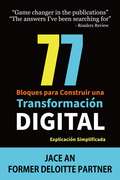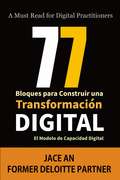- Table View
- List View
Practical Text Analytics: Maximizing the Value of Text Data (Advances in Analytics and Data Science #2)
by Murugan Anandarajan Chelsey Hill Thomas NolanThis book introduces text analytics as a valuable method for deriving insights from text data. Unlike other text analytics publications, Practical Text Analytics: Maximizing the Value of Text Data makes technical concepts accessible to those without extensive experience in the field. Using text analytics, organizations can derive insights from content such as emails, documents, and social media. Practical Text Analytics is divided into five parts. The first part introduces text analytics, discusses the relationship with content analysis, and provides a general overview of text mining methodology. In the second part, the authors discuss the practice of text analytics, including data preparation and the overall planning process. The third part covers text analytics techniques such as cluster analysis, topic models, and machine learning. In the fourth part of the book, readers learn about techniques used to communicate insights from text analysis, including data storytelling. The final part of Practical Text Analytics offers examples of the application of software programs for text analytics, enabling readers to mine their own text data to uncover information.
How COVID-19 is Accelerating the Digital Revolution: Challenges and Opportunities
by R. Anandan G. Suseendran Pushpita Chatterjee Noor Zaman Jhanjhi Uttam GhoshThis book explores how digital technologies have proved to be a useful and necessary tool to help ensure that local and regional governments on the frontline of the emergency can continue to provide essential public services during the COVID-19 crisis. Indeed, as the demand for digital technologies grows, local and regional governments are increasingly committed to improving the lives of their citizens under the principles of privacy, freedom of expression and democracy.The Digital Revolution began between the late 1950s and 1970s and represents the evolution of technology from the mechanical and analog to the digital. The advent of digital technology has also changed how humans communicate – today using computers, smartphones and the internet. Further, the digital revolution has made a tremendous wealth of information accessible to virtually everyone. In turn, the book focuses on key challenges for local and regional governments concerning digital technologies during this crisis, e.g. the balance between privacy and security, the digital divide, and accessibility. Privacy is a challenge in the mitigation of COVID-19, as governments rely on digital technologies like contact-tracking apps and big data to help trace peoples’ patterns and movements. While these methods are controversial and may infringe on rights to privacy, they also appear to be effective measures for rapidly controlling and limiting the spread of the virus. Next, the book discusses the 10 technology trends that can help build a resilient society, as well as their effects on how we do business, how we work, how we produce goods, how we learn, how we seek medical services and how we entertain ourselves. Lastly, the book addresses a range of diversified technologies, e.g. Online Shopping and Robot Deliveries, Digital and Contactless Payments, Remote Work, Distance Learning, Telehealth, Online Entertainment, Supply Chain 4.0, 3D Printing, Robotics and Drones, 5G, and Information and Communications Technology (ICT).
Human Communication Technology: Internet-of-Robotic-Things and Ubiquitous Computing (Artificial Intelligence and Soft Computing for Industrial Transformation)
by R. Anandan G. Suseendran S. Balamurugan Ashish Mishra D. BalaganeshHUMAN COMMUNICATION TECHNOLOGY A unique book explaining how perception, location, communication, cognition, computation, networking, propulsion, integration of federated Internet of Robotic Things (IoRT) and digital platforms are important components of new-generation IoRT applications through continuous, real-time interaction with the world. The 16 chapters in this book discuss new architectures, networking paradigms, trustworthy structures, and platforms for the integration of applications across various business and industrial domains that are needed for the emergence of intelligent things (static or mobile) in collaborative autonomous fleets. These new apps speed up the progress of paradigms of autonomous system design and the proliferation of the Internet of Robotic Things (IoRT). Collaborative robotic things can communicate with other things in the IoRT, learn independently, interact securely with the world, people, and other things, and acquire characteristics that make them self-maintaining, self-aware, self-healing, and fail-safe operational. Due to the ubiquitous nature of collaborative robotic things, the IoRT, which binds together the sensors and the objects of robotic things, is gaining popularity. Therefore, the information contained in this book will provide readers with a better understanding of this interdisciplinary field. Audience Researchers in various fields including computer science, IoT, artificial intelligence, machine learning, and big data analytics.
Industrial Internet of Things (IIoT): Intelligent Analytics for Predictive Maintenance
by R. Anandan Suseendran Gopalakrishnan Souvik Pal Noor ZamanINDUSTRIAL INTERNET OF THINGS (IIOT) This book discusses how the industrial internet will be augmented through increased network agility, integrated artificial intelligence (AI) and the capacity to deploy, automate, orchestrate, and secure diverse user cases at hyperscale. Since the internet of things (IoT) dominates all sectors of technology, from home to industry, automation through IoT devices is changing the processes of our daily lives. For example, more and more businesses are adopting and accepting industrial automation on a large scale, with the market for industrial robots expected to reach $73.5 billion in 2023. The primary reason for adopting IoT industrial automation in businesses is the benefits it provides, including enhanced efficiency, high accuracy, cost-effectiveness, quick process completion, low power consumption, fewer errors, and ease of control. The 15 chapters in the book showcase industrial automation through the IoT by including case studies in the areas of the IIoT, robotic and intelligent systems, and web-based applications which will be of interest to working professionals and those in education and research involved in a broad cross-section of technical disciplines. The volume will help industry leaders by Advancing hands-on experience working with industrial architecture Demonstrating the potential of cloud-based Industrial IoT platforms, analytics, and protocols Putting forward business models revitalizing the workforce with Industry 4.0. Audience Researchers and scholars in industrial engineering and manufacturing, artificial intelligence, cyber-physical systems, robotics, safety engineering, safety-critical systems, and application domain communities such as aerospace, agriculture, automotive, critical infrastructures, healthcare, manufacturing, retail, smart transports, smart cities, and smart healthcare.
Computational Intelligence and Sustainable Systems: Intelligence and Sustainable Computing (EAI/Springer Innovations in Communication and Computing)
by H. Anandakumar R. Arulmurugan Chow Chee OnnThis book features research related to computational intelligence and energy and thermal aware management of computing resources. The authors publish original and timely research in current areas of power, energy, temperature, and environmental engineering as and advances in computational intelligence that are benefiting the fields. Topics include signal processing architectures, algorithms, and applications; biomedical informatics and computation; artificial intelligence and machine learning; green technologies in information; and more. The book includes contributions from a wide range of researchers, academicians, and industry professionals. The book is made up both of extended papers presented at the International Conference on Intelligent Computing and Sustainable System (ICICSS 2018), September 20-21, 2018, and other accepted papers on R&D and original research work related to the practice and theory of technologies to enable and support Intelligent Computing applications.
Propeller Programming: Using Assembler, Spin, And C
by Sridhar AnandakrishnanLearn to program the Propeller in Spin and C and how to map the Propeller Assembler (PASM) language from other high-level languages you might know.The overall task you will pursue in the book is to implement a Delta Compression algorithm: first in Spin, then in PASM, then in C. Along the way, you'll review test driven development, a powerful technique for validating code, and conclude with a chapter on hardware manipulations. The book's main goal is to help you extend the capabilities of the Propeller processor by using the assembler language.What You’ll LearnUse a data compression/decompression application to introduce PASM to the readerIntegrate C and PASM codeReview hardware interactions (setting and reading pins)Who This Book Is ForThose who are familiar with Spin programming for the Parallax Propeller but have an interest in learning Propeller C and Propeller Assembler (PASM) programming. Some knowledge of C or Python is also helpful.
A Guide for Machine Vision in Quality Control
by Sheila Anand L. PriyaMachine Vision systems combine image processing with industrial automation. One of the primary areas of application of Machine Vision in the Industry is in the area of Quality Control. Machine vision provides fast, economic and reliable inspection that improves quality as well as business productivity. Building machine vision applications is a challenging task as each application is unique, with its own requirements and desired outcome. A Guide to Machine Vision in Quality Control follows a practitioner’s approach to learning machine vision. The book provides guidance on how to build machine vision systems for quality inspections. Practical applications from the Industry have been discussed to provide a good understanding of usage of machine vision for quality control. Real-world case studies have been used to explain the process of building machine vision solutions. The book offers comprehensive coverage of the essential topics, that includes: Introduction to Machine Vision Fundamentals of Digital Images Discussion of various machine vision system components Digital image processing related to quality control Overview of automation The book can be used by students and academics, as well as by industry professionals, to understand the fundamentals of machine vision. Updates to the on-going technological innovations have been provided with a discussion on emerging trends in machine vision and smart factories of the future. Sheila Anand is a PhD graduate and Professor at Rajalakshmi Engineering College, Chennai, India. She has over three decades of experience in teaching, consultancy and research. She has worked in the software industry and has extensive experience in development of software applications and in systems audit of financial, manufacturing and trading organizations. She guides Ph.D. aspirants and many of her research scholars have since been awarded their doctoral degree. She has published many papers in national and international journals and is a reviewer for several journals of repute. L Priya is a PhD graduate working as Associate Professor and Head, Department of Information Technology at Rajalakshmi Engineering College, Chennai, India. She has nearly two decades of teaching experience and good exposure to consultancy and research. She has delivered many invited talks, presented papers and won several paper awards in International Conferences. She has published several papers in International journals and is a reviewer for SCI indexed journals. Her areas of interest include Machine Vision, Wireless Communication and Machine Learning.
Integration of IoT with Cloud Computing for Smart Applications (Chapman & Hall/CRC Cloud Computing for Society 5.0)
by Rohit Anand Sapna Juneja Abhinav Juneja Vishal Jain Ramani KannanIntegration of IoT with Cloud Computing for Smart Applications provides an integrative overview of the Internet of Things (IoT) and cloud computing to be used for the various futuristic and intelligent applications. The aim of this book is to integrate IoT and cloud computing to translate ordinary resources into smart things. Discussions in this book include a broad and integrated perspective on the collaboration, security, growth of cloud infrastructure, and real-time data monitoring. Features: Presents an integrated approach to solve the problems related to security, reliability, and energy consumption. Explains a unique approach to discuss the research challenges and opportunities in the field of IoT and cloud computing. Discusses a novel approach for smart agriculture, smart healthcare systems, smart cities and many other modern systems based on machine learning, artificial intelligence, and big data, etc. Information presented in a simplified way for students, researchers, academicians and scientists, business innovators and entrepreneurs, management professionals and practitioners. This book can be great reference for graduate and postgraduate students, researchers, and academicians working in the field of computer science, cloud computing, artificial intelligence, etc.
Meta-Heuristic Algorithms for Advanced Distributed Systems
by Rohit Anand Abhinav Juneja Digvijay Pandey Sapna Juneja Nidhi SindhwaniMETA-HEURISTIC ALGORITHMS FOR ADVANCED DISTRIBUTED SYSTEMS Discover a collection of meta-heuristic algorithms for distributed systems in different application domains Meta-heuristic techniques are increasingly gaining favor as tools for optimizing distributed systems—generally, to enhance the utility and precision of database searches. Carefully applied, they can increase system effectiveness, streamline operations, and reduce cost. Since many of these techniques are derived from nature, they offer considerable scope for research and development, with the result that this field is growing rapidly. Meta-Heuristic Algorithms for Advanced Distributed Systems offers an overview of these techniques and their applications in various distributed systems. With strategies based on both global and local searching, it covers a wide range of key topics related to meta-heuristic algorithms. Those interested in the latest developments in distributed systems will find this book indispensable. Meta-Heuristic Algorithms for Advanced Distributed Systems readers will also find: Analysis of security issues, distributed system design, stochastic optimization techniques, and more Detailed discussion of meta-heuristic techniques such as the genetic algorithm, particle swam optimization, and many others Applications of optimized distribution systems in healthcare and other key??industries Meta-Heuristic Algorithms for Advanced Distributed Systems is ideal for academics and researchers studying distributed systems, their design, and their applications.
System Reliability Management: Solutions and Technologies (Advanced Research in Reliability and System Assurance Engineering)
by Adarsh Anand Mangey RamThis book provides the latest research advances in the field of system reliability assurance and engineering. It contains reference material for applications of reliability in system engineering, offering a theoretical sound background with adequate numerical illustrations. Included are concepts pertaining to reliability analysis, assurance techniques and methodologies, tools, and practical applications of system reliability modeling and allocation. The collection discusses various soft computing techniques like artificial intelligence and particle swarm optimization approach for reliability assessment. Importance of differentiating between the optimal release time and testing stop time of the software has been explicitly discussed and presented in the book. Features: Creates understanding of the costs associated with complex systems Covers reliability measurement of engineering systems Incorporates an efficient effort-based expenditure policy incorporating cost and reliability criteria Provides information for optimal testing stop and release time of software system Presents software performance and security layout Addresses reliability prediction and its maintenance through advanced analytics techniques Overall, System Reliability Management: Solutions and Techniques is a collaborative and interdisciplinary approach for better communication of problems and solutions to increase the performance of the system for better utilization and resource management.
Intelligent Data Engineering and Automated Learning – IDEAL 2020: 21st International Conference, Guimaraes, Portugal, November 4–6, 2020, Proceedings, Part I (Lecture Notes in Computer Science #12489)
by Cesar Analide Paulo Novais David Camacho Hujun YinThis two-volume set of LNCS 12489 and 12490 constitutes the thoroughly refereed conference proceedings of the 21th International Conference on Intelligent Data Engineering and Automated Learning, IDEAL 2020, held in Guimaraes, Portugal, in November 2020.*The 93 papers presented were carefully reviewed and selected from 134 submissions. These papers provided a timely sample of the latest advances in data engineering and machine learning, from methodologies, frameworks, and algorithms to applications. The core themes of IDEAL 2020 include big data challenges, machine learning, data mining, information retrieval and management, bio-/neuro-informatics, bio-inspiredmodels, agents and hybrid intelligent systems, real-world applications of intelligent techniques and AI. * The conference was held virtually due to the COVID-19 pandemic.
Intelligent Data Engineering and Automated Learning – IDEAL 2020: 21st International Conference, Guimaraes, Portugal, November 4–6, 2020, Proceedings, Part II (Lecture Notes in Computer Science #12490)
by Cesar Analide Paulo Novais David Camacho Hujun YinThis two-volume set of LNCS 12489 and 12490 constitutes the thoroughly refereed conference proceedings of the 21th International Conference on Intelligent Data Engineering and Automated Learning, IDEAL 2020, held in Guimaraes, Portugal, in November 2020.*The 93 papers presented were carefully reviewed and selected from 134 submissions. These papers provided a timely sample of the latest advances in data engineering and machine learning, from methodologies, frameworks, and algorithms to applications. The core themes of IDEAL 2020 include big data challenges, machine learning, data mining, information retrieval and management, bio-/neuro-informatics, bio-inspiredmodels, agents and hybrid intelligent systems, real-world applications of intelligent techniques and AI. * The conference was held virtually due to the COVID-19 pandemic.
IoT-enabled Unobtrusive Surveillance Systems for Smart Campus Safety
by Theodoros AnagnostopoulosIoT-enabled Unobtrusive Surveillance Systems for Smart Campus Safety Enables readers to understand a broad area of state-of-the-art research in physical IoT-enabled security IoT-enabled Unobtrusive Surveillance Systems for Smart Campus Safety describes new techniques in unobtrusive surveillance that enable people to act and communicate freely, while at the same time protecting them from malevolent behavior. It begins by characterizing the latest on surveillance systems deployed at smart campuses, miniatures of smart cities with more demanding frameworks that enable learning, social interaction, and creativity, and by performing a comparative assessment in the area of unobtrusive surveillance systems for smart campuses. A proposed taxonomy for IoT-enabled smart campus unfolds in five research dimensions: (1) physical infrastructure; (2) enabling technologies; (3) software analytics; (4) system security; and (5) research methodology. By applying this taxonomy and by adopting a weighted scoring model on the surveyed systems, the book presents the state of the art and then makes a comparative assessment to classify the systems. Finally, the book extracts valuable conclusions and inferences from this classification, providing insights and directions towards required services offered by unobtrusive surveillance systems for smart campuses. IoT-enabled Unobtrusive Surveillance Systems for Smart Campus Safety includes specific discussion of: Smart campus’s prior work taxonomies and classifications, a proposed taxonomy, and an adopted weight scoring model Personal consumer benefits and potential social dilemmas encountered when adopting an unobtrusive surveillance system Systems that focus on smart buildings, public spaces, smart lighting and smart traffic lights, smart labs, and smart campus ambient intelligence A case study of a spatiotemporal authentication unobtrusive surveillance system for smart campus safety and emerging issues for further research directions IoT-enabled Unobtrusive Surveillance Systems for Smart Campus Safety is an essential resource for computer science and engineering academics, professionals, and every individual who is working and doing research in the area of unobtrusive surveillance systems and physical security to face malevolent behavior in smart campuses.
Hands-On Software Engineering with Golang: Move beyond basic programming to design and build reliable software with clean code
by Achilleas AnagnostopoulosExplore software engineering methodologies, techniques, and best practices in Go programming to build easy-to-maintain software that can effortlessly scale on demand Key Features Apply best practices to produce lean, testable, and maintainable Go code to avoid accumulating technical debt Explore Go's built-in support for concurrency and message passing to build high-performance applications Scale your Go programs across machines and manage their life cycle using Kubernetes Book Description Over the last few years, Go has become one of the favorite languages for building scalable and distributed systems. Its opinionated design and built-in concurrency features make it easy for engineers to author code that efficiently utilizes all available CPU cores. This Golang book distills industry best practices for writing lean Go code that is easy to test and maintain, and helps you to explore its practical implementation by creating a multi-tier application called Links 'R' Us from scratch. You'll be guided through all the steps involved in designing, implementing, testing, deploying, and scaling an application. Starting with a monolithic architecture, you'll iteratively transform the project into a service-oriented architecture (SOA) that supports the efficient out-of-core processing of large link graphs. You'll learn about various cutting-edge and advanced software engineering techniques such as building extensible data processing pipelines, designing APIs using gRPC, and running distributed graph processing algorithms at scale. Finally, you'll learn how to compile and package your Go services using Docker and automate their deployment to a Kubernetes cluster. By the end of this book, you'll know how to think like a professional software developer or engineer and write lean and efficient Go code. What you will learn Understand different stages of the software development life cycle and the role of a software engineer Create APIs using gRPC and leverage the middleware offered by the gRPC ecosystem Discover various approaches to managing package dependencies for your projects Build an end-to-end project from scratch and explore different strategies for scaling it Develop a graph processing system and extend it to run in a distributed manner Deploy Go services on Kubernetes and monitor their health using Prometheus Who this book is for This Golang programming book is for developers and software engineers looking to use Go to design and build scalable distributed systems effectively. Knowledge of Go programming and basic networking principles is required.
Playing with Feelings: Video Games And Affect
by Aubrey AnableHow gaming intersects with systems like history, bodies, and code Why do we so compulsively play video games? Might it have something to do with how gaming affects our emotions? In Playing with Feelings, scholar Aubrey Anable applies affect theory to game studies, arguing that video games let us “rehearse” feelings, states, and emotions that give new tones and textures to our everyday lives and interactions with digital devices. Rather than thinking about video games as an escape from reality, Anable demonstrates how video games—their narratives, aesthetics, and histories—have been intimately tied to our emotional landscape since the emergence of digital computers.Looking at a wide variety of video games—including mobile games, indie games, art games, and games that have been traditionally neglected by academia—Anable expands our understanding of the ways in which these games and game studies can participate in feminist and queer interventions in digital media culture. She gives a new account of the touchscreen and intimacy with our mobile devices, asking what it means to touch and be touched by a game. She also examines how games played casually throughout the day create meaningful interludes that give us new ways of relating to work in our lives. And Anable reflects on how games allow us to feel differently about what it means to fail.Playing with Feelings offers provocative arguments for why video games should be seen as the most significant art form of the twenty-first century and gives the humanities passionate, incisive, and daring arguments for why games matter.
Problem Solving for Wireless Sensor Networks
by Ana-Belén García-Hernando Juan-Manuel López-Navarro Aggeliki Prayati Luis Redondo-López José-Fernán Martínez-OrtegaProblem Solving for Wireless Sensor Networks delivers a comprehensive review of the state of the art in the most important technological issues related to Wireless Sensor Networks (WSN). It covers topics such as hardware platforms, radio technologies, software technologies (including middleware), and network and deployment aspects. This book discusses the main open issues inside each of these categories and identifies innovations considered most interesting for future research. Features: - Hardware Platforms in WSN, - Software Technologies in SWN, - Network Aspects and Deployment in WSN, - Standards and Safety Regulation for WSN, - European Projects Related to WSN, - WSN Application Scenarios at both utility and technical levels. Complete, cutting-edge and resulting from the work of many recognized researchers, Problem Solving for Wireless Sensor Networks is an invaluable reference for graduates and researchers, as well as practitioners.
Decision Support Systems XII: 8th International Conference on Decision Support System Technology, ICDSST 2022, Thessaloniki, Greece, May 23–25, 2022, Proceedings (Lecture Notes in Business Information Processing #447)
by Ana Paula Cabral Seixas Costa Jason Papathanasiou Uchitha Jayawickrama Daouda KamissokoThis book constitutes the proceedings of the 8th International Conference on Decision Support Systems Technologies, ICDSST 2022, held during May 23-25, 2022.The EWG-DSS series of International Conference on Decision Support System Technology (ICDSST) is planned to consolidate the tradition of annual events organized by the EWG-DSS in offering a platform for European and international DSS communities, comprising the academic and industrial sectors, to present state-of-the-art DSS research and developments, to discuss current challenges that surround decision-making processes, to exchange ideas about realistic and innovative solutions, and to co-develop potential business opportunities. The main aim of this year’s conference is to investigate the role DSS and related technologies can play in mitigating the impact of pandemics and post-crisis recovery. The 15 papers presented in this volume were carefully reviewed and selected from 46 submissions. They were organized in topical sections as follows: decision support addressing modern industry; decision support addressing business and societal needs, and multiple criteria approaches.
Online Social Networking on Campus: Understanding What Matters in Student Culture
by Ana M. Martínez-Alemán Katherine Lynk WartmanIn the era of such online spaces as Facebook, Instant Messenger, Live Journal, Blogger, Web Shots, and campus blogs, college students are using these resources and other online sites as a social medium. Inevitably, this medium presents students with ethical decisions about social propriety, self disclosure and acceptable behaviour. Because online social networking sites have proven problematic for college students and for college administrators, this book aims to offer professional guidance to Higher Education administrators and policy makers. Online Social Networking on Campus: Understanding what matters in student culture is a professional guide for Higher Education faculty and Student Affairs administrators, which rigorously examines college students’ use of online social networking sites and how they use these to develop relationships both on and off campus. Most importantly, Online Social Networking on Campus investigates how college students use online sites to explore and makes sense of their identities. Providing information taken from interviews, surveys and focus group data, the book presents an ethnographic view of social networking that will help Student Affairs administrators, Information Technology administrators, and faculty better understand and provide guidance to the "neomillennials" on their campuses.
Pattern Recognition Applications and Methods: 5th International Conference, ICPRAM 2016, Rome, Italy, February 24-26, 2016, Revised Selected Papers (Lecture Notes in Computer Science #10163)
by Ana Fred, Maria Marsico and Gabriella Sanniti di BajaThis book contains revised and extended versions of selected papers from the 5th International Conference on Pattern Recognition, ICPRAM 2016, held in Rome, Italy, in February 2016.The 13 full papers were carefully reviewed and selected from 125 initial submissions and describe up-to-date applications of pattern recognition techniques to real-world problems, interdisciplinary research, experimental and/or theoretical studies yielding new insights that advance pattern recognition methods.
Advances in Artificial Intelligence – IBERAMIA 2022: 17th Ibero-American Conference on AI, Cartagena de Indias, Colombia, November 23–25, 2022, Proceedings (Lecture Notes in Computer Science #13788)
by Ana Cristina Bicharra Garcia Mariza Ferro Julio Cesar Rodríguez RibónThis book constitutes the refereed proceedings of the 17th Ibero-American Conference on Artificial Intelligence, IBERAMIA 2022, held in Cartagena de Indias, Colombia, in November 2022. The 33 full and 4 short papers presented were carefully reviewed and selected from 67 submissions. The papers are organized in the following topical sections: applications of AI; ethics and smart city; green and sustainable AI; machine learning; natural language processing; robotics and computer vision; simulation and forecasting.
Biomedical Engineering Systems and Technologies: 15th International Joint Conference, BIOSTEC 2022, Virtual Event, February 9–11, 2022, Revised Selected Papers (Communications in Computer and Information Science #1814)
by Ana Cecília A. Roque Denis Gracanin Ronny Lorenz Athanasios Tsanas Nathalie Bier Ana Fred Hugo GamboaThis book constitutes the refereed post-proceedings of the 15th International Conference on Biomedical Engineering Systems and Technologies, BIOSTEC 2022, held as a Virtual Event, during February 9–11, 2022. The 21 full papers included in this book were carefully reviewed and selected from 262 submissions. The papers selected to be included in this book contribute to the understanding of relevant trends of current research on Biomedical Engineering Systems and Technologies, including: Pattern Recognition and Machine Learning, Application of Health Informatics in Clinical Cases, Evaluation and Use of Healthcare IT, Medical Signal Acquisition, Analysis and Processing, Data Mining and Data Analysis, Decision Support Systems, e-Health, e-Health Applications, Mobile Technologies for Healthcare Applications and Medical Devices design.
Proceedings of the 3rd International Conference on Electrical and Information Technologies for Rail Transportation: Electrical Traction (Lecture Notes In Electrical Engineering #482)
by Min An Lijun Diao Jianghua Feng Jianguo Suo Yong Qin Limin JiaThe proceedings collect the latest research trends, methods and experimental results in the field of electrical and information technologies for rail transportation. The topics cover novel traction drive technologies of rail transportation, safety technology of rail transportation system, rail transportation information technology, rail transportation operational management technology, rail transportation cutting-edge theory and technology etc. The proceedings can be a valuable reference work for researchers and graduate students working in rail transportation, electrical engineering and information technologies.
Proceedings of the 3rd International Conference on Electrical and Information Technologies for Rail Transportation: Electrical Traction (Lecture Notes In Electrical Engineering #482)
by Min An Lijun Diao Jianghua Feng Jianguo Suo Yong Qin Limin JiaThe proceedings collect the latest research trends, methods and experimental results in the field of electrical and information technologies for rail transportation. The topics cover novel traction drive technologies of rail transportation, safety technology of rail transportation system, rail transportation information technology, rail transportation operational management technology, rail transportation cutting-edge theory and technology etc. The proceedings can be a valuable reference work for researchers and graduate students working in rail transportation, electrical engineering and information technologies.
77 Bloques para Construir una Transformación Digital: Explicación Simplificada
by Jace AnEn 2018, ‘77 Bloques para Construir una Transformación Digital: Modelo de Capacidad Digital’ fue publicado para asistir a los ‘practicantes digitales’ quienes trabajan en el espacio digital. Desde entonces, pocos lectores me han sugerido escribir un libro sobre la transformación digital para ‘el público en general’ que estuviere interesado en aprender más que lo básico sobre la transformación digital. Es así que he creado este libro ‘77 Bloques para Construir una Transformación Digital: Explicación Simplificada’. Este libro intenta entregar los mensajes claves de ‘77 Bloques para Construir una Transformación Digital: Modelo de Capacidad Digital’ al público en general. Dicho esto, este no pretende ser un libro de teoría que discuta las ideas y conceptos académicos de la transformación digital, sino un libro práctico de campo que describe las capacidades digitales probadas como los bloques de construcción para la transformación digital. ‘77 Bloques para Construir una Transformación Digital: Explicación Simplificada’ se enfoca en introducir 77 bloques de construcción para asistir al público en general a comprender las ‘prácticas reales’ en el espacio digital, aunque no cubre totalmente el Modelo de Madurez descripto en detalle en ‘77 Bloques para Construir una Transformación Digital: Modelo de Capacidad Digital’ que asiste a los practicantes digitales con indicadores de madurez de las capacidades digitales. Este libro proporciona unos pocos ejemplos de indicadores de mayor madurez como una introducción al Modelo de Madurez de las Capacidades Digitales.
77 Bloques para Construir una Transformación Digital: El Modelo de Capacidad Digital
by Jace AnEste no es un libro sobre teoría que discuta conceptos académicos de transformaración digital, sino que se orienta a la práctica de campo que describe cómo asesorar y mejorar las capacidades digitales de una organización. Más bien satisface mejor a los ‘practicantes digitales’, quienes están involucrados en operaciones de negocios digitales, incluyendo tecnología informática y digital, comercio electrónico, servicios de atención al cliente online y muchas otras áreas operativas en las que la tecnología informática podría tener impacto. La capacidad digital está definida en este libro como la capacidad organizativa y la habilidad para producir resultados de negocio intencionales en el espacio digital al combinar procesos, personas y elementos tecnológicos de un modo único para cada organización. Los elementos del proceso incluyen flujo de proceso, información de entrada y salida; reglas del negocio; políticas y lineamientos. El elemento humano incluye una estructura y cultura organizacional; roles, responsabilidades y habilidades de las personas. Los elementos tecnológicos incluyen aplicaciones; infraestructura de datos; instalaciones y equipos alrededor de la tecnología digital. La capacidad de escucha del diálogo social está definida, por ejemplo, como una capacidad organizativa para entender de qué están hablando los usuarios en las redes sociales y utilizarlo para un negocio al combinar procesos bien definidos, las habilidades del personal y sus evidentes roles y responsabilidades, como también las herramientas de automatización. Una mayor madurez dentro de las capacidades digitales asegura operaciones efectivas y eficientes dentro de los negocios digitales. Las operaciones de los negocios digitales están dentro de un área multidisciplinaria donde convergen los negocios y la Tecnología Informática que trabajan en conjunto para producir resultados comerciales en el espacio digital. Enten
